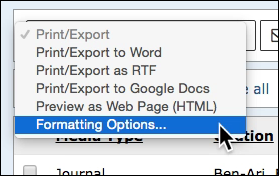
Before you print/export your source list and open it in your word processor or Google Docs, NoodleTools allows you to do some basic formatting. To see the formatting options, click Print/Export at the top of your source list and select Formatting Options…

Keep in mind that formatting options affect only the list that is open. Other projects in your personal folder will not change. The formatting options are:
List title
By default, MLA lists are titled “Works Cited,” APA lists are titled “References,” and Chicago lists are titled “Bibliography.” These are the most common titles, but you may want a title that reflects the contents of your particular source list. For example:
Page header (APA only)
A “header” is information that appears at the top of each page of your paper. The APA Publication Manual states that the header should consist of a shortened version (50 characters or fewer) of the title of your paper (all capital letters, flush left), and the page number (flush right, continued from the body of the paper). If you are not writing a paper that will be published, a header is generally not required (you can ask your teacher if you aren’t sure). NoodleTools can add the header to your source list for you, correctly formatted (although you will still need to make sure that it also appears throughout your essay).
Include or omit annotations
If you have included annotations in your source list but you do not wish them to appear in the version you print or export, you can omit them:
Note that your annotations will no longer appear in your source list, even though you can still edit existing or add new annotations.
Other formatting
To change other document formatting, such as fonts and line spacing, wait until your source list is complete and then make the changes after you have opened your source list in a word processing program or Google Docs.
How to export as Word or RTF and add it to your research paper
1. Click Print/Export and choose to Word (which generates a .docx file) or as RTF. While Microsoft Word is often used, .rtf files can be opened in any word processor that supports that file format standard (nearly all word processors do).
2. When you choose to export to a .rtf or .docx file, there are a few possible workflows:
Now that the file has been saved to your computer, open it and copy and paste the source list to the end of your research paper. It is customary to begin your source list on a new page, not on the last page of your research paper.
NOTE: Do not re-save a .rtf file as a .rtf file after opening it in Word. Doing so can cause formatting issues due to the way Word handles certain RTF codes. Instead, save as .docx.
How to export to a Google Doc and add it to your research paper
To export your source list to a Google Doc:
How to preview the source list (HTML)
NoodleTools allows you to preview your formatted source list as an HTML-based webpage:
How to print your source list
The final version of your source list should always be printed after it is exported and viewed in your word processor or Google Docs. Do not print your source list from the Preview version because that webpage represents only a close approximation of the correct spacing and formatting.